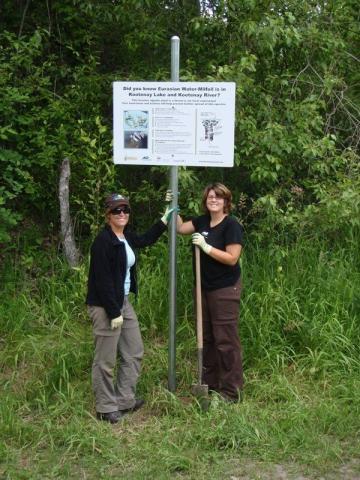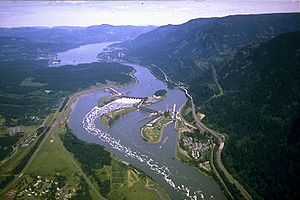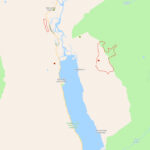Boaters' help needed to help protect Kootenay waterways
Boaters are being asked to beware of an invasive weed cauding problems in regional waterways, and now showing up here in the West Kootenay.
Photo by Barb Houston: Anneli Schadeli (left) and Claire Schadeli (right) during sign installation.
Eurasian watermilfoil (Myriophyllum spicatum L.) has been a troublesome aquatic invader in B.C. since the 1970s, impacting waterways throughout the province. Unfortunately, a recent survey funded by the Fish and Wildlife Compensation Program and Fortis BC confirmed that this aquatic invader has made its way into the Kootenay River system. Thick mats were detected in the Kootenay River and plants were also found at several locations in Kootenay Lake.
The problem is that this non-native, immersed rooted perennial aquatic plant spreads rapidly and forms dense canopies of vegetation. These thick beds of tangled stems can interfere with recreational activities such as boating swimming, fishing, and diving, and can also alter the ecology of a water body by reducing water quality, impacting fish and wildlife habitat and killing native plants. It is found in a variety of habitats including lakes, ponds, reservoirs, rivers and streams and can tolerate a wide range of environmental conditions. It is especially well adapted at colonizing new areas and even small fragments, such as those trapped on engine propellers or recreational vehicles, can start a new infestation, and once it is established it is nearly impossible to eradicate.
In an effort to educate the public and prevent the spread of Eurasian watermilfoil, the Central Kootenay Invasive Plant Committee, along with project partners including the Fish and Wildlife Compensation Program, BC Ministry of Environment, and Fortis BC have developed informational signs that were installed earlier this summer at several boat launches throughout the area. The goal of the signage is to inform the public about the problem, provide details on how to identify the plant and to prevent the spread by encouraging people to clean all recreational equipment including boats, trailers, motors, anchors, live wells, bilges, bait buckets, fishing and diving gear.
It can be somewhat difficult to tell the difference between the native milfoil species and the Eurasian invader, but a good rule of thumb is that generally Eurasian watermilfoil has between 12 to 24 pairs of thread-like leaflets; where as the native milfoils have less than 12 pairs of leaflets. Early detection of this invasive plant is critical, so if you think you may have seen Eurasian watermilfoil, or would like more information, please contact the Central Kootenay Invasive Plant Committee by phone at (250) 352-1160 or e-mail at coordinator@kootenayweeds.com . You can also visit their website www.kootenayweeds.com


























Comments